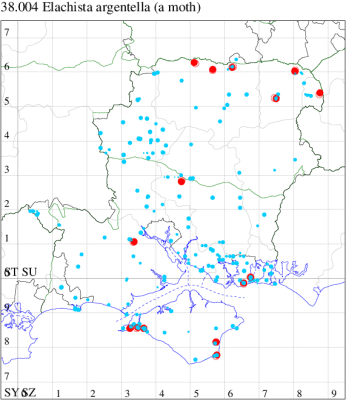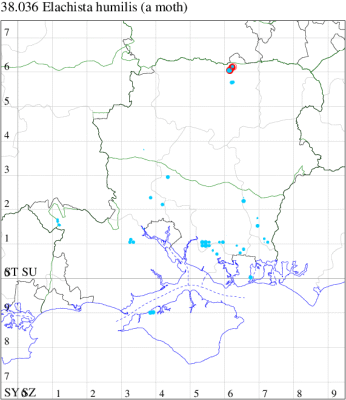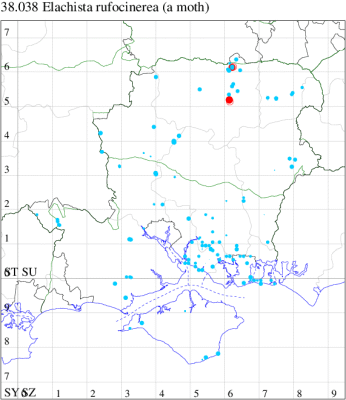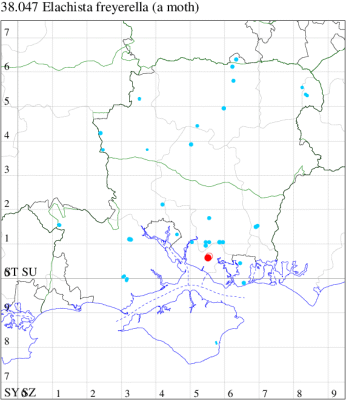2020 Annual Report for: Elachistidae / Elachistinae
For species seen in 2020 that had less than or equal to 100 records, full details are included; for more common species, the earliest, latest and highest count by vice-county are shown. The narrative for each species is taken from the main Hantsmoths website, and it is possible that some information on abundance and occurrence can get out of date, as it is impossible to keep up with all changes; however it should give a good introduction to each species. The tables in each species account summarise the previous status, and that for the current year.
For the maps, all records prior to 2020 are shown by a blue dot (the larger the dot, the more recent), with the current year's records shown in red. As previous records are superimposed on any report for 2020, new sites have greater emphasis (i.e. will show as 'more red').
In the species accounts, an asterisk next to a location indicates a new 10km square record; earliest ever dates are highlighted in orange, and latest ever in red. Initials in the species accounts refer to the recorders listed here. Please get in touch if you identify any omissions or errors, in particular if you have records that have yet to be submitted. Details of how to submit records can be found here.
38.004 [B&F: 0610] Elachista argentella (Clerck, 1759) - Common
Common in grassland and saltmarshes throughout much of the British Isles. In Hampshire and on the Isle of Wight widespread and common, particularly near the coast. Wingspan 11-12 mm. The only plain white species other than Mendesia farinella, from which it can be separated by its smaller size, non-ciliate antenna and reduced venation (MBGBI Vol 3). Larva mines leaves of various grasses.
Records prior to 2020
| Vice County | #Records | #Individuals | First Record | Last Record |
|---|---|---|---|---|
| 10 | 82 | 112 | 1856 | 2019 |
| 11 | 303 | 385 | 1972 | 2019 |
| 12 | 86 | 120 | 1976 | 2019 |
2020 records
| Vice County | #Records | #Individuals | Max Quantity |
|---|---|---|---|
| 10 | 12 | 12 | 1 |
| 11 | 4 | 4 | 1 |
| 12 | 6 | 6 | 1 |

Records by year
Records by week (adult)
Records by week (larval)
Record Details
VC10: Tennyson Down, one, field observation, 07 Jun (IOu); Freshwater Cliffs, one, field observation, 16 May (SDa); Afton Chalk Pit, one, 13 May (IOu); Bonchurch, one, 21 May; one, 25 May; one, 26 May; one, 27 May (JHa); Shanklin, one, 21 May; one, 14 Jun; one, 17 Jun; one, 25 Jun; one, 06 Jul (IOu);
VC11: Ashurst, NF, one, 15 May (SAB); Southampton, one, field observation, 07 May (MEdg); Winchester, one, 07 Aug (THW); Portsmouth, one, 06 May (IRT); Southsea, one, 21 May (JRL);
VC12: Headley Gravel Pit*, one, field observation, 06 May (GJD); Axmansford*, one, field observation, 09 May; one, 12 Jun (ACB); Basingstoke*, one, field observation, 08 May (SGdw); Pamber Forest, one, 18 May (GJD); Odiham Common, one, netted, 19 May (JHH, AMD); Farnborough, one, 09 May; one, field observation, 15 May (KBW); Yateley*, one, 27 May; one, 26 May (JHH)
38.005 [B&F: 0611] Elachista triatomea (Haworth, 1828) - Local
Found in open grassland, hillsides and clifftops, throughout central and eastern England and south-eastern Scotland, also in central and western Scotland and Ireland (MBGBI Vol 3). In Hampshire and Isle of Wight, there are scattered records from downland across all three vice-counties, but never common. Wingspan 8-9mm. The dark ciliary line and dark spots on the fold and at the apex of the cell are diagnostic (MBGBI Vol 3). Larva mines the leaves of Sheep's-fescue and Red Fescue.
Records prior to 2020
| Vice County | #Records | #Individuals | First Record | Last Record |
|---|---|---|---|---|
| 10 | 3 | 3 | 1947 | 2015 |
| 11 | 7 | 8 | 1985 | 2018 |
| 12 | 12 | 17 | 1940 | 2019 |
2020 records
| Vice County | #Records | #Individuals | Max Quantity |
|---|---|---|---|
| 12 | 1 | 1 | 1 |

Records by year
Records by week (adult)
Records by week (larval)
Record Details
VC11: Bishop's Waltham*, one, field observation, 17 Jun (DTr);
VC12: Barton Stacey, one, to actinic, 27 May (GCE)
38.015 [B&F: 0620] Elachista gangabella Zeller, 1850 - Local
Local in woodland in southern England and Wales, rare elsewhere. Very sparsely, but widely, distributed across Hampshire and the Isle of Wight. Wingspan 9-10 mm. Distinguished from all other unifasciate Elachista species by the dark apical cilia on the forewing (MBGBI Vol 3). Larva mines leaves of Cock's-foot and False-brome.
Records prior to 2020
| Vice County | #Records | #Individuals | First Record | Last Record |
|---|---|---|---|---|
| 10 | 8 | 12 | 1977 | 2010 |
| 11 | 52 | 33 | 1982 | 2019 |
| 12 | 26 | 5 | 1975 | 2011 |
2020 records
| Vice County | #Records | #Individuals | Max Quantity |
|---|---|---|---|
| 12 | 1 | 1 | 1 |

Records by year
Records by week (adult)
Records by week (larval)
Record Details
VC12: Pamber Forest*, one, 30 May (GJD)
38.023 [B&F: 0595] Elachista biatomella (Stainton, 1848) - Nationally Scarce B
Nationally scarce (Nb) on open grassland and heathland throughout England and Wales. In Hampshire restricted to sites such as Portsdown Hill, Martin Down and Oxenbourne Down, with occasional records elsewhere, including one on the Isle of Wight on Culver Down, Bembridge. Wingspan 7-9 mm. Larva mines leaves of Glaucous Sedge.
Records prior to 2020
| Vice County | #Records | #Individuals | First Record | Last Record |
|---|---|---|---|---|
| 10 | 7 | 1 | 1900 | 2018 |
| 11 | 24 | 34 | 1971 | 2018 |
| 12 | 3 | 2 | 1976 | 2013 |
2020 records
| Vice County | #Records | #Individuals | Max Quantity |
|---|---|---|---|
| 11 | 1 | 1 | 1 |

Records by year
Records by week (adult)
Records by week (larval)
Record Details
VC11: Portsmouth, one, 18 Jul (IRT)
38.025 [B&F: 0597] Elachista atricomella Stainton, 1849 - Common
Common on roadside verges, woodland edges and waste ground throughout the British Isles. Probably under-recorded in Hampshire and on the Isle of Wight, where the extent of known records correlate with those areas in which the recording effort is concentrated. Wingspan 11-13 mm. Well-marked males, with dark head and centrally weak fascia are distinctive, but poorly marked specimens can only be identified by dissection of the genitalia. Larva mines leaves of Cock's-foot.
Records prior to 2020
| Vice County | #Records | #Individuals | First Record | Last Record |
|---|---|---|---|---|
| 10 | 16 | 17 | 1967 | 2019 |
| 11 | 63 | 82 | 1972 | 2019 |
| 12 | 75 | 108 | 1976 | 2019 |
2020 records
| Vice County | #Records | #Individuals | Max Quantity |
|---|---|---|---|
| 11 | 3 | 3 | 1 |
| 12 | 3 | 3 | 1 |

Records by year
Records by week (adult)
Records by week (larval)
Record Details
VC11: Kings Somborne, one, to actinic, 26 May; one, to actinic, 15 Jul (GCE); Winchester, one, 13 Jun (THW);
VC12: Harewood Forest, one, to actinic, 23 May; Barton Stacey, one, to actinic, 27 May; one, to actinic, 27 May (GCE); Ropley, two, 26 May (TJN, LF); Yateley*, one, ♂, gen det, 26 May (JHH det. AMD)
38.030 [B&F: 0601] Elachista albifrontella (Hübner, [1817]) - Common
Common in grassland, woodland and gardens throughout much of the British Isles, but apparently absent from the extreme north of Scotland, the Orkney and Shetland Isles (MBGBI Vol 3). In Hampshire widespread and fairly common; on the Isle of Wight, recorded only one, at Bembridge in June 1969. Wingspan 8-9 mm. Similar to E. apicipunctella, which see for differences. Larva mines leaves of various grasses.
Records prior to 2020
| Vice County | #Records | #Individuals | First Record | Last Record |
|---|---|---|---|---|
| 10 | 4 | 1 | 1850 | 1969 |
| 11 | 121 | 468 | 1968 | 2019 |
| 12 | 22 | 12 | 1940 | 2018 |
2020 records
| Vice County | #Records | #Individuals | Max Quantity |
|---|---|---|---|
| 11 | 1 | 1 | 1 |
| 12 | 4 | 4 | 1 |

Records by year
Records by week (adult)
Records by week (larval)
Record Details
VC11: Portsmouth, one, 19 Jun (IRT);
VC12: Pamber Forest, one, 08 Jun; one, 10 Jun; one, 17 Jun; one, 19 Jul (GJD); Odiham Common, one, field observation, 04 Jun (AMD, JHH); Foxlease Meadow, Rushmoor, one, field observation, ♂, gen det, 28 May (JHH det. AMD)
38.032 [B&F: 0602] Elachista apicipunctella Stainton, 1849 - Local
Local along woodland edges and in woodland clearings throughout much of the British Isles, except for the extreme south-west of England. In Hampshire there is a single old record from "Southampton" in 1937, but the precise place where the specimen was taken is uncertain (MBGBI Vol 3). No more was heard of the species in the county until May 2002, when one was found in a Rothamsted trap at West Park. There have been further scattered records from 2020 onwards. Not recorded from the Isle of Wight to date. Wingspan 10-11 mm. Similar to E. albifrontella, but the extra subapical spot beyond the costal and tornal spots of the forewing on E. apicipunctella is diagnostic. Larva mines leaves of various grasses.
Records prior to 2020
| Vice County | #Records | #Individuals | First Record | Last Record |
|---|---|---|---|---|
| 11 | 1 | 1 | 1937 | 1937 |
| 12 | 1 | 4 | 2018 | 2018 |
2020 records
| Vice County | #Records | #Individuals | Max Quantity |
|---|---|---|---|
| 12 | 1 | 1 | 1 |

Records by year
Records by week (adult)
Records by week (larval)
Record Details
VC12: Pamber Forest, one, 16 Apr (GJD)
38.036 [B&F: 0606] Elachista humilis Zeller, 1850 - Common
Common in a wide range of habitats throughout much of Britain, but not in the Highlands or Islands of Scotland; rare in Ireland. In Hampshire reasonably well-distributed in the south of the county, but very infrequent in the north and on the Isle of Wight; probably under-recorded. Wingspan 9-10 mm. The male is extremely similar to the small, poorly-marked upland form of E. alpinella from which it can often reliably be separated only by dissection of the genitalia (MBGBI Vol 3). Larva mines leaves of various grasses.
Records prior to 2020
| Vice County | #Records | #Individuals | First Record | Last Record |
|---|---|---|---|---|
| 10 | 4 | 4 | 1986 | 2015 |
| 11 | 127 | 145 | 1983 | 2017 |
| 12 | 8 | 11 | 1992 | 2018 |
2020 records
| Vice County | #Records | #Individuals | Max Quantity |
|---|---|---|---|
| 12 | 5 | 6 | 2 |

Records by year
Records by week (adult)
Records by week (larval)
Record Details
VC12: Pamber Forest, two, 28 May; two, 30 May; one, 14 Jun; one, 21 Apr (GJD)
38.037 [B&F: 0607] Elachista canapennella (Hübner, [1813]) - Common
Common in grassland throughout much of the British Isles. In Hampshire widespread and reasonably common, but perhaps under-recorded; there have been no recent records from the Isle of Wight. Wingspan 8-10 mm. The male is usually recognisable by its pale grey-brown forewings that are almost devoid of markings (MBGBI Vol 3). Larva mines leaves of various grasses.
Records prior to 2020
| Vice County | #Records | #Individuals | First Record | Last Record |
|---|---|---|---|---|
| 10 | 66 | 78 | 1900 | 2019 |
| 11 | 766 | 1078 | 1968 | 2019 |
| 12 | 87 | 135 | 1994 | 2019 |
2020 records
| Vice County | #Records | #Individuals | Max Quantity |
|---|---|---|---|
| 10 | 30 | 54 | 8 |
| 11 | 30 | 38 | 3 |
| 12 | 1 | 2 | 2 |

Records by year
Records by week (adult)
Records by week (larval)
Record Details
VC10: Totland, one, 20 Sep (RTe); Freshwater, one, to actinic, gen det, 12 Sep (PBa); Shanklin, one, gen det, 05 Apr; two, 10 Apr; one, 11 Apr; one, 12 Apr; one, 16 Apr; three, 20 Apr; three, 21 Apr; two, 22 Apr; one, 23 Apr; three, 25 Apr; one, 27 Apr; one, 28 Apr; three, 02 May; three, 03 May; two, 12 May; one, 15 May; three, 18 May; one, 19 May; eight, 20 May; one, 22 May; one, 25 May; one, 02 Jun; three, 01 Jul; one, 22 Jul; one, 17 Aug; one, 10 Sep; Shanklin Upper Chine, one, 21 May; one, 25 May (IOu);
VC11: Pig Bush, NF, one, gen det, 17 Jul (CL); Woodlands, New Forest, present, 13 May (RBW); Totton, one, 21 Apr; one, 23 Apr; three, 02 May; one, 07 May; one, 08 May; one, 09 May; two, 27 May; two, 15 Jun; one, 16 Jun; one, 22 Jun; one, 24 Jun; one, 29 Jun; one, 30 Jun; two, 05 Jul; one, 07 Jul; one, 15 Jul; one, 24 Jul (LH); Romsey, one, 16 Apr; one, 20 Apr; two, 02 May; two, 08 May; one, 21 Jun (MB); Southampton, one, 11 Sep (MEdg); one, to actinic, 08 May (MGP); Eastleigh, one, to actinic, 10 Jul (KArb); Hilltop, The Hangers, one, 01 Aug (SI); Sway, one, 19 May; one, 24 Jun (SKe); Southsea, one, 22 Apr; three, 02 May; one, 16 May (JRL);
VC12: Pamber Forest, two, 10 Jun (GJD); Yateley*, one, ♂, gen det, 26 May (JHH det. AMD)
38.038 [B&F: 0608] Elachista rufocinerea (Haworth, 1828) - Common
Common in grassland, bogs and heaths throughout the British Isles, but not in northern Scotland. The distribution in Hampshire mirrors those areas in which trapping effort is concentrated, and the moth is probably more widely distributed than the records suggest, but very infrequently recorded on the Isle of Wight. Wingspan 10-11 mm. The reddish ochreous suffusion on a plain ochreous-white ground is diagnostic (MBGBI Vol 3). Larva mines leaves of various grasses.
Records prior to 2020
| Vice County | #Records | #Individuals | First Record | Last Record |
|---|---|---|---|---|
| 10 | 14 | 8 | 1850 | 2018 |
| 11 | 162 | 350 | 1968 | 2019 |
| 12 | 41 | 51 | 1971 | 2019 |
2020 records
| Vice County | #Records | #Individuals | Max Quantity |
|---|---|---|---|
| 12 | 4 | 14 | 5 |

Records by year
Records by week (adult)
Records by week (larval)
Record Details
VC12: Basingstoke, three, to actinic, 26 Jun (JHu); Pamber Forest, three, 21 Apr; three, 24 Apr; five, 27 Apr (GJD)
38.039 [B&F: 0609] Elachista maculicerusella (Bruand, 1859) - Common
Common in fens and marshes and by rivers and canals throughout much of the British Isles, extending into Scotland as far north as the southern Highlands (MBGBI Vol 3). In Hampshire, widespread and common, but not recorded from the Isle of Wight until one in 2021. Wingspan 10mm. Fairly distinctive, although frequently quite variable. Larva mines leaves of Reed Canary-grass and Common Reed.
Records prior to 2020
| Vice County | #Records | #Individuals | First Record | Last Record |
|---|---|---|---|---|
| 11 | 49 | 59 | 1900 | 2019 |
| 12 | 49 | 61 | 1980 | 2018 |
2020 records
| Vice County | #Records | #Individuals | Max Quantity |
|---|

Records by year
Records by week (adult)
Records by week (larval)
Record Details
VC12: Yateley*, one, 07 Aug (JHH)
38.047 [B&F: 0631] Elachista freyerella (Hübner, [1825]) - Local
Local in damp meadows and woodland rides throughout the British Isles. In Hampshire recorded regularly only at Botley Wood, elsewhere in the county, and on the Isle of Wight, recorded very occasionally, and absent from many ten-kilometre squares. Wingspan 7-8 mm. Usually impossible to separate from C. consortella and C. stabilella without dissection of the genitalia, but C. freyerella tends to be darker with more obvious fasciae. Larva mines leaves of various grasses.
Records prior to 2020
| Vice County | #Records | #Individuals | First Record | Last Record |
|---|---|---|---|---|
| 10 | 4 | 3 | 1928 | 1984 |
| 11 | 90 | 119 | 1972 | 2014 |
| 12 | 16 | 13 | 1971 | 2011 |
2020 records
| Vice County | #Records | #Individuals | Max Quantity |
|---|---|---|---|
| 11 | 1 | 1 | 1 |

Records by year
Records by week (adult)
Records by week (larval)
Record Details
VC11: Catisfield, one, 07 Aug (ALR det. RJD)
38.048 [B&F: 0632] Elachista consortella Stainton, 1851 - Nationally Scarce B
Nationally scarce (Nb) on open grassland in widely scattered localities throughout Britain and Ireland, absent from the extreme north of Scotland and the northern half of Ireland (MBGBI Vol 3). In Hampshire records are thinly distributed across much of the county, and it is no doubt overlooked - recorded from the Isle of Wight for the first time in 2020. Wingspan 7-8 mm. Only reliably recorded by dissection of the genitalia. Larva mines leaves of Annual Meadow-grass.
Records prior to 2020
| Vice County | #Records | #Individuals | First Record | Last Record |
|---|---|---|---|---|
| 11 | 26 | 27 | 1983 | 2015 |
| 12 | 6 | 5 | 1993 | 2011 |
2020 records
| Vice County | #Records | #Individuals | Max Quantity |
|---|---|---|---|
| 10 | 1 | 1 | 1 |

Records by year
Records by week (adult)
Records by week (larval)
Record Details
VC10: New Vice-county Record: Totland*, one, 18 Sep (RTe)
